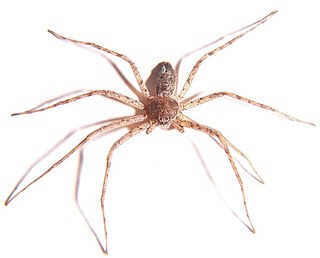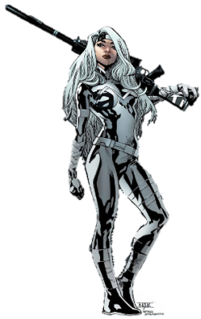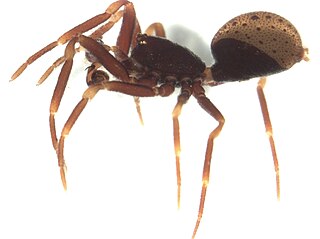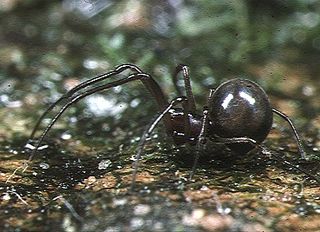
The Thomisidae are a family of spiders, including about 175 genera and over 2,100 species. The common name crab spider is often linked to species in this family, but is also applied loosely to many other families of spiders. Many members of this family are also known as flower spiders or flower crab spiders.

The family Dipluridae, known as curtain-web spiders are a group of spiders in the infraorder Mygalomorphae, that have two pairs of booklungs, and chelicerae (fangs) that move up and down in a stabbing motion. A number of genera, including that of the Sydney funnel-web spider (Atrax), used to be classified in this family but have now been moved to Hexathelidae.

Latrodectus is a broadly distributed genus of spiders with several species that, together, are referred to as true widows. This group is composed of those often loosely called black widow spiders, brown widow spiders, and similar spiders. However, such general "common names" are of limited use as the diversity of species is much greater. A member of the family Theridiidae, this genus contains 32 species, which include several North American "black widows". In addition to these in North America are also the red widow Latrodectus bishopi and the brown widow Latrodectus geometricus, which, in addition to North America, has a much wider geographic distribution. Elsewhere, others include the European black widow, the Australian redback black widow, several different species in Southern Africa that can be called Button spiders, and the South American black widow spiders. Species vary widely in size. In most cases, the females are dark-coloured, but some may have lighter bodies or even reddish. Many can have red, white or brown markings on the upper-side (dorsal) of the abdomen. Some can be readily identifiable by reddish markings on the central underside (ventral) abdomen, which are often hourglass-shaped.

Philodromidae, also known as philodromid crab spiders and running crab spiders, is a family of araneomorph spiders first described by Tord Tamerlan Teodor Thorell in 1870. It contains over 600 species in thirty genera. Most are dull colored- brown, gray, yellowish or mottled with a leaf-like cardiac mark on the anterior dorsal abdomen, and seldom reach above 10 millimetres (0.39 in) long. None of the species build webs, but they do use silk for draglines and egg sacs.

Ant spiders are members of the family Zodariidae. They are small to medium-sized eight-eyed spiders found in all tropical and subtropical regions of South America, Africa, Madagascar, Australia-New Guinea, New Zealand, Arabia and the Indian subcontinent. Most species are daytime hunters and live together with ants, mimicking their behavior and sometimes even their chemical traits. Although little is known about most zodariids, members of the genus Zodarion apparently feed only on ants; a number of other genera in the family are apparently also ant specialists.

Scaffold web spiders (Nesticidae) is a family of araneomorph spiders closely allied with tangle web spiders. Like the "Theridiidae", these spiders have a comb of serrated bristles on the hind tarsi that are used to pull silk bands from the spinnerets. It contains 16 genera and about 300 species, many of which are associated with caves or overhangs. The genus Nesticus is the type for the family and is found throughout the world. The related Eidmannella has speciated considerably in Texas caves and includes some extremely localized species that are considered threatened. One species, Eidmannella pallida, is found in caves and under overhangs, but also in agricultural fields and other habitats away from such restricted areas. The genus Carpathonesticus is found in central Eurasia.

Silver Sable is a fictional character appearing in American comic books published by Marvel Comics. She is usually depicted as a mercenary, hunter of war criminals, leader of the Wild Pack, and owner of Silver Sable International. While not a criminal, her work as a mercenary has sometimes brought her into conflict with several superheroes. Silver Sable is primarily an ally and sometimes enemy of Spider-Man.

Arthur Gardiner Butler F.L.S., F.Z.S. (1844–1925) was an English entomologist, arachnologist and ornithologist. He worked at the British Museum on the taxonomy of birds, insects, and spiders.

Gradungulidae, also known as large-clawed spiders, is a spider family endemic to Australia and New Zealand. They are medium to large-sized haplogyne spiders with three claws and two pairs of book-lungs similar to Mygalomorphae. Some species build extensive webs with an upper retreat tangle and connecting threads to scaffolding. This supports the ladder-like catching platform that is glued to the ground. Progradungula, a large spider with long legs like Hickmania, and Macrogradungula are the only cribellate genera of the family.

Malkaridae is a small family of araneomorph spiders first described by V. T. Davies in 1980. In 2017, the family Pararchaeidae was brought into synonymy with Malkaridae.

Anapidae is a family of rather small spiders with 231 described species in 58 genera. It includes the former family Micropholcommatidae as the subfamily Micropholcommatinae, and the former family Holarchaeidae. Most species are less than 2 millimetres (0.079 in) long.
Carathea is a genus of Tasmanian spiders within the family Malkaridae that was named and first described by R. J. Moran in 1986. The name comes from the Australian aboriginal word for "sister". The type species is C. parawea. The features unique to spiders of this genus include a thin tip to the conductor, the absence of "horns" on the carapace, and, in females, the internal genitalia are large and less compact, usually only containing three or four coils.
Neoaviola is a monotypic genus of Australian dwarf sheet spiders containing the single species, Neoaviola insolens. It was first described by Arthur Gardiner Butler in 1929, and has only been found in Australia. It might be a synonym for Rinawa.
Eterosonycha is a genus of spiders in the family Anapidae. It was first described in 1932 by Butler. As of 2016, it contains 4 Australian species.
Micropholcomma is a genus of spiders in the family Anapidae. It was first described in 1927 by Crosby & Bishop. As of 2017, it contains 8 Australian species.
Corasoides is a genus of South Pacific intertidal spiders that was first described by Arthur Gardiner Butler in 1929. Originally placed with the Agelenidae, it was moved to the Stiphidiidae in 1973, and to the Desidae after a 2017 genetic study.
Microctenonyx is a genus of dwarf spiders that was first described by Friedrich Dahl in 1886.
Naatlo is a genus of ray spiders that was first described by Jonathan A. Coddington in 1986.










